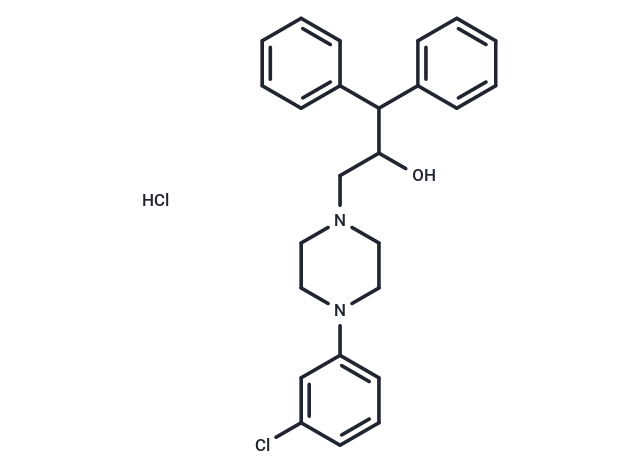Shopping Cart
- Remove All
 Your shopping cart is currently empty
Your shopping cart is currently empty

BRL-15572 dihydrochloride (BRL 15573 dihydrochloride) is a 5-HT1D receptor antagonist with pKi of 7.9, also shows a considerable affinity at 5-HT1A and 5-HT2B receptors, exhibiting 60-fold selectivity over 5-HT1B receptor.

| Pack Size | Price | Availability | Quantity |
|---|---|---|---|
| 5 mg | $41 | In Stock | |
| 10 mg | $66 | In Stock | |
| 25 mg | $108 | In Stock | |
| 50 mg | $166 | In Stock | |
| 100 mg | $248 | In Stock | |
| 200 mg | $373 | In Stock | |
| 1 mL x 10 mM (in DMSO) | $43 | In Stock |
| Description | BRL-15572 dihydrochloride (BRL 15573 dihydrochloride) is a 5-HT1D receptor antagonist with pKi of 7.9, also shows a considerable affinity at 5-HT1A and 5-HT2B receptors, exhibiting 60-fold selectivity over 5-HT1B receptor. |
| Targets&IC50 | 5-HT7:6.3(pKi), 5-HT1D:7.9(pKi), 5-HT2A:6.6(pKi), 5-HT2B:7.4(pKi), 5-HT1A:7.7(pKi) |
| In vitro | BRL-15572 displays high affinity and selectivity for h5-HT1D receptors. BRL-15572 has 60-fold higher affinity for h5-HT1D than 5-HT1B receptors. BRL-15572 binds to h5-HT1B and h5-HT1D receptors with pKB of less than 6 and 7.1, respectively. BRL-15572 stimulates [35S]GTP γ S binding in both cell lines, with potencies that correlated with their receptor binding affinities in both h5-HT1B and h5-HT1D receptor expressing cell lines. BRL-15572 reveals receptor binding affinities for 5-HT1A, 5-HT1B, 5-HT1E, 5-HT1F, 5-HT2A, 5-HT2B, 5-HT2C, 5-HT6 and 5-HT7 with pKi of 7.7, 6.1, 5.2, 6.0, 6.6, 7.4, 6.2, 5.9 and 6.3, respectively. In the h5-HT1D cell line, both BRL-15572 (1 μM) shifts the 5-HT concentration response curve with pKB of 7.1, respectively. BRL-15572 does have moderately high affinity at human 5-HT1A and 5-HT2B receptors. [1] In human atrial appendages, the electrically evoked tritium overflow is inhibited by 5-HT in a manner susceptible to antagonism by BRL-15572 (300 nM; 23 times Ki at h5-HT1D receptors). [2] The inhibitory effect of 5-HT on the K+-evoked overflow of glutamate is antagonized by the h5-HT1D receptor ligand BRL-15572. BRL-15572 (1 μM) is unable to modify the effect of 5-HT at the autoreceptor regulating [3H]5-HT release. [3] The selective 5-HT1D/1B receptor antagonist BRL 15572 inhibits the effect of the agonist L-694 247. [4] |
| In vivo | In diabetic pithed rats, administration of the selective 5-HT1D receptor antagonist BRL-15572 (2 mg/kg) does not modify the decreased HR induced by vagal electrical stimulation. The effects of L-694,247 (50 μg/kg), a selective agonist for non-rodent 5-HT1B and 5-HT1D receptors, on the vagally induced bradycardia are not apparent after pretreatment with BRL-15572. [5] |
| Cell Research | [35S]GTPγS binding studies. [35S]GTPγS binding studies in CHO cells expressing the h5-HT1B or h5-HT1D receptors are performed. In brief, membranes from 1 × 106 cells are preincubated at 30°C for 30 minutes, in HEPES buffer (HEPES [20 mM], MgCl2 [3 mM], NaCl [100 mM], ascorbate [0.2 mM]), containing GDP (10 μ M), with or without BRL-15572. The reaction is started by the addition of 10 μL of [35S]GTPγS (100 pM, assay concentration) followed by a further 30 minutes incubation at 30°C. Non-specific binding is determined by addition of unlabelled GTPγS (10 μM), prior to the addition of cells. The reaction is stopped by rapid filtration using Whatman GF/B grade filters followed by five washes with ice-cold HEPES buffer. Radioactivity is determined by liquid scintillation spectrometry.(Only for Reference) |
| Alias | BRL 15573 dihydrochloride |
| Molecular Weight | 479.87 |
| Formula | C25H27ClN2O·2HCl |
| Cas No. | 193611-72-2 |
| Smiles | Cl.OC(CN1CCN(CC1)c1cccc(Cl)c1)C(c1ccccc1)c1ccccc1 |
| Relative Density. | no data available |
| Storage | Powder: -20°C for 3 years | In solvent: -80°C for 1 year | Shipping with blue ice. | ||||||||||||||||||||||||||||||||||||||||
| Solubility Information | DMSO: 89 mg/mL (185.47 mM), Sonication is recommended. H2O: < 1 mg/mL (insoluble or slightly soluble) Ethanol: 38 mg/mL (79.19 mM), Sonication is recommended. | ||||||||||||||||||||||||||||||||||||||||
Solution Preparation Table | |||||||||||||||||||||||||||||||||||||||||
Ethanol/DMSO
DMSO
| |||||||||||||||||||||||||||||||||||||||||

Copyright © 2015-2025 TargetMol Chemicals Inc. All Rights Reserved.